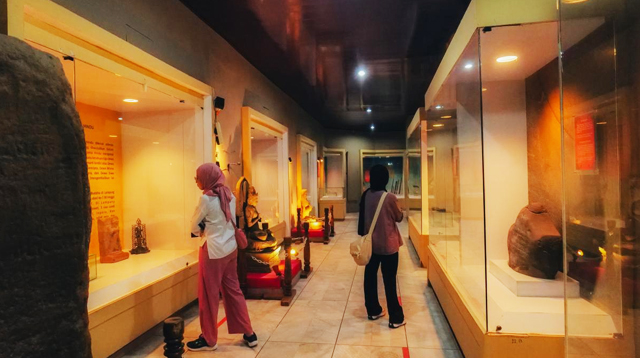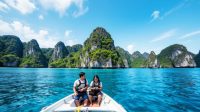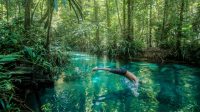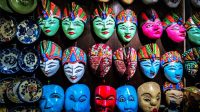LAMPUNG Province, located at the southern tip of Sumatra Island, is known for its stunning natural wealth, from white sandy beaches to national parks that harbor biodiversity. However, behind its natural beauty, Lampung also holds invaluable cultural and historical heritage, one of which is beautifully captured at the Lampung Museum. A visit to this museum is not only a journey into the past, but also a gateway to explore the charm of other tourist attractions scattered around it.
Traces of History and Culture in the Heart of Bandar Lampung
The Lampung Museum administratively located at Jalan ZA Pagar Alam No. 64, Bandar Lampung stands majestically as the first and largest museum in the province. Its strategic location, not far from the city center and easily accessible from all directions, makes it an educational tourist destination that is a shame to miss.
The Lampung Museum officially opened in 1988 has the full name ‘Lampung Ruwa Jurai Museum’, taken from the slogan on the Lampung Province symbol, namely ‘Sai Bumi Ruwa Jurai.’
This museum is the pride of the Lampung people, functioning as a center for preservation, research, and dissemination of information about the history, culture, and natural resources of Bumi Ruwa Jurai.
From Ancient Artifacts to Traditional Heritage
Entering the Lampung Museum, visitors will be presented with a variety of collections reflecting the long journey of civilization in Lampung. More than 4,500 historical objects are neatly arranged, providing a comprehensive picture of the province’s past. The collection is classified into several main categories:
- Archaeology: This section stores prehistoric artifacts such as nekara (bronze drums) that were once used in important ceremonies, bronze vessels from the Bronze Age, and various ancient ceramics from various periods, including the Chinese, Vietnamese, Thai, Persian and European dynasties. The existence of these foreign ceramics is evidence of trade and cultural interactions between the Lampung people and other nations in the past.
- Ethnography: The ethnographic collection displays the cultural richness of the Lampung people, especially from the two main ethnic groups, namely Lampung Pepadun and Lampung Saibatin. Visitors can see beautiful and meaningful tapis cloth, traditional clothing with distinctive ornaments, traditional weapons such as keris (terapang), traditional musical instruments such as gamolan, and replicas of traditional Lampung houses (Lamban Pesagi) which show the progress of traditional architecture.
- History: This section stores objects related to the struggle for independence and the development of modern Lampung Province. Photos of important figures, historical documents, and other relevant artifacts provide insight into the historical journey of Lampung in a national context.
- Numismatics and Heraldry: This collection displays various types of currency that have circulated in Lampung, both local and foreign currencies, as well as service medals and government equipment that have been used.
- Biology and Geology: Although the museum’s main focus is history and culture, there are also collections that showcase Lampung’s biodiversity, including dioramas of rare animals that live in this region, as well as examples of geological formations.
One of the museum’s icons that greets visitors in the front yard is a five-ton iron ball. This object has its own historical value because it was used to open transmigration land around the 1950s, becoming a symbol of the spirit of development and progress of Lampung.
Exploring the Charm of Tourism Around the Lampung Museum
After enriching their knowledge about Lampung’s history and culture at the museum, tourists can continue their adventure by visiting various interesting tourist attractions located around Bandar Lampung:
- Puncak Mas: Located not too far from the city center, Puncak Mas offers a beautiful view of Bandar Lampung City from a height, especially at night with the sparkling city lights. This place also has various instagrammable photo spots and other recreational facilities.
- PKOR Way Halim: As a center for sports and recreation activities, PKOR (Sport Center) Way Halim is the right place to relax and enjoy the local atmosphere. On weekends, this place is crowded with residents to exercise or just spend time with family.
- National Transmigration Museum: Located in Pesawaran District, not too far from Bandar Lampung, this museum preserves traces of the history of transmigration in Indonesia, including the important role of Lampung as one of the transmigration destinations.
- Beaches in Pesawaran: Pesawaran Regency, which can be easily reached from Bandar Lampung, offers stunning beach beauty, such as Pahawang Island which is famous for its underwater beauty, Mutun Beach, and Klara Beach which offers various water activities.
- National Park nal Way Kambas: Although further away, Way Kambas National Park is a must-visit for nature lovers. Here, tourists can see Sumatran elephants, rhinos, tigers, and various other wildlife in their natural habitat.
Conclusion: More than Just a Museum
Lampung Museum is more than just a place to store ancient artifacts. It is a window that connects the past to the present, providing a deeper understanding of Lampung’s identity and cultural richness. With its strategic location in Bandar Lampung and its proximity to various other interesting tourist attractions, Lampung Museum is an ideal destination to explore the historical, cultural, and natural charms that Lampung Province has to offer. A visit to this museum will enrich your travel experience and provide unforgettable memories of Bumi Ruwa Jurai. (*)










